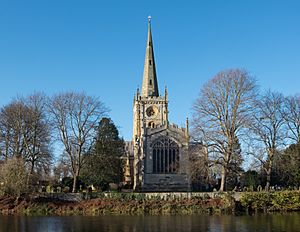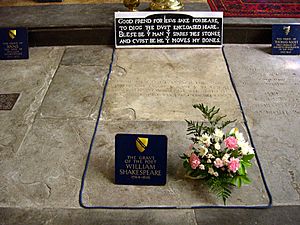Church of the Holy Trinity, Stratford-upon-Avon facts for kids
Quick facts for kids Holy Trinity Church |
|
|---|---|
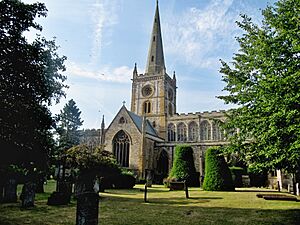
The church
|
|
| Country | England |
| Denomination | Church of England |
| Previous denomination | Catholic |
| Churchmanship | Broad Church |
| Website | www.stratford-upon-avon.org/ |
| History | |
| Dedication | Holy Trinity |
| Administration | |
| Parish | Stratford-upon-Avon |
| Diocese | Coventry |
| Province | Canterbury |
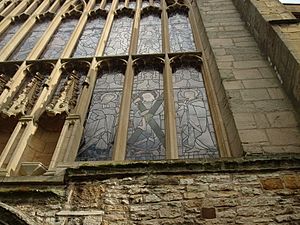
The Holy Trinity Church in Stratford-upon-Avon, England, is a very old and important church. It's officially called the Collegiate Church of the Holy and Undivided Trinity. Many people also know it as Shakespeare's Church. This is because the famous writer William Shakespeare was baptised and buried here. Over 200,000 visitors come to see the church every year. It is a parish church, which means it serves the local community.
Contents
History of the Church
The church building you see today dates back to 1210. It was built on the site of an even older Saxon monastery. This makes it the oldest building in Stratford-upon-Avon. It sits right by the River Avon and is one of England's most visited churches.
In the 1300s, a special chapel for prayers, called a chantry, was started by John de Stratford. This chapel was rebuilt between 1465 and 1497 by Dean Thomas Balshall, who is buried in the church. People believe the church first had a wooden spire, which is the tall, pointed part of the roof. This was replaced with a new one in 1763 by William Hiorne.
Holy Trinity Church has many interesting old features, including:
- A special metal ring on the porch door from the 1300s. This was used by people seeking safety inside the church.
- The Clopton chantry chapel from the 1400s.
- Twenty-six carved wooden seats from the 1400s in the main part of the church. These seats have carvings of religious, everyday, and mythical scenes.
- Large stained glass windows at both ends of the church. They show important English and Biblical saints.
- The "American window" in St Peter's Chapel. This window was put in place in 1896. It says, "The Gift of America to Shakespeare's Church."
- Copies of the official records of William Shakespeare's baptism and burial.
Some of the carved scenes of Jesus's life around Balshall's tomb were damaged during the Reformation. This was a time of big changes in the church. However, some beautiful old stained glass windows survived. They show the Resurrection and Ascension of Jesus, and the Day of Pentecost. An old stone altar slab was found hidden under the floor. It has now been put back as the main altar.
The Church Organ
The church has a large pipe organ with three keyboards. It was built in 1841 by William Hill. The organ has been repaired and updated several times. It now has two separate parts. One part is high on the wall, and the other is on the ground floor. The organ case, which is its outer shell, was designed by George Frederick Bodley and Thomas Garner.
Organists of Holy Trinity
Many talented musicians have played the organ at Holy Trinity Church. Here are a few:
- C. J. Read, who played in the mid-1800s.
- Henry Mathews, who played for a very long time, from around 1858 to 1937.
- John Cook, who was the organist from 1949 to 1954.
- Peter Summers, who served from 1979 to 2006.
- Stephen Dodsworth, who was the organist from 2019 to 2020.
- Douglas Keilitz, who has been the director of music since 2020.
Visiting the Church
The Holy Trinity Church is open to visitors for most of the year. You can explore much of the church for free. There is a small fee to enter the area where William Shakespeare is buried.
The church is an active place of worship. It serves about 17,000 people in its local area. In 2006, the Royal Shakespeare Company performed the play Henry VIII inside the church. This was part of a special festival. Another interesting feature is a tall stone monument. It was put up in 1858 to remember William Cheshire, who was a printer and botanist.
Shakespeare's Connection
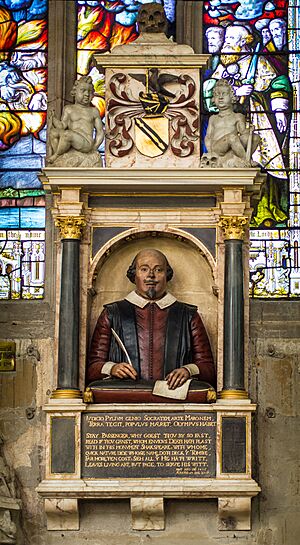
William Shakespeare, the famous poet and playwright, was baptised at Holy Trinity Church on April 26, 1564. He was buried there on April 25, 1616. The church still has the original records of his baptism and burial. These important documents are kept safe by the Shakespeare Birthplace Trust.
Shakespeare is buried in the 15th-century part of the church. This area was built by Thomas Balsall. Shakespeare was allowed to be buried there because he had a special connection to the church. His wife, Anne Hathaway, is buried next to him. Their oldest daughter, Susanna Shakespeare, is also buried nearby.
Shakespeare's monument is on a wall near his grave. This monument was repaired in 1746. The money for the repairs came from a performance of Shakespeare's play Othello. This was the first time a Shakespeare play was recorded as being performed in Stratford-upon-Avon.
Shakespeare would have visited Holy Trinity Church every week when he was living in Stratford. This includes his childhood and when he returned later in life.
Above Shakespeare's grave, there is an old stone slab with his epitaph (a short text about a dead person). It says:
Good frend for Iesvs sake forbeare,
to digg the dvst encloased heare.
Bleste be ye man yt spares thes stones,
and cvrst be he yt moves my bones.
Some people believe this warning has stopped anyone from moving Shakespeare's body to Westminster Abbey. It may also have prevented his body from being dug up for study.
Anne Hathaway's grave is next to her husband's. The writing on her grave says, "Heere lyeth interred the body of Anne wife of William Shakespeare who dep[ar]ted this life the 6th day of Avgv[st] 1623 being of the age of 67 yeares". There is also a Latin message. It talks about how Anne gave life and how much she is missed. It also expresses a wish for her to rise again. This message might have been written by John Hall for his wife, Susanna, who was Anne's daughter.
Church Extension
In January 2015, plans were approved to build an extension next to the south side of the church. This new part provides a new vestry (a room for priests' robes), toilets, and storage space. Construction started in 2015, and the extension opened on April 17, 2016. It was designed by Stephen Oliver Architecture and built using local limestone. A stained-glass window that was once hidden by the organ is now part of this new extension.
See also
 In Spanish: Iglesia de la Santísima Trinidad de Stratford-upon-Avon para niños
In Spanish: Iglesia de la Santísima Trinidad de Stratford-upon-Avon para niños


